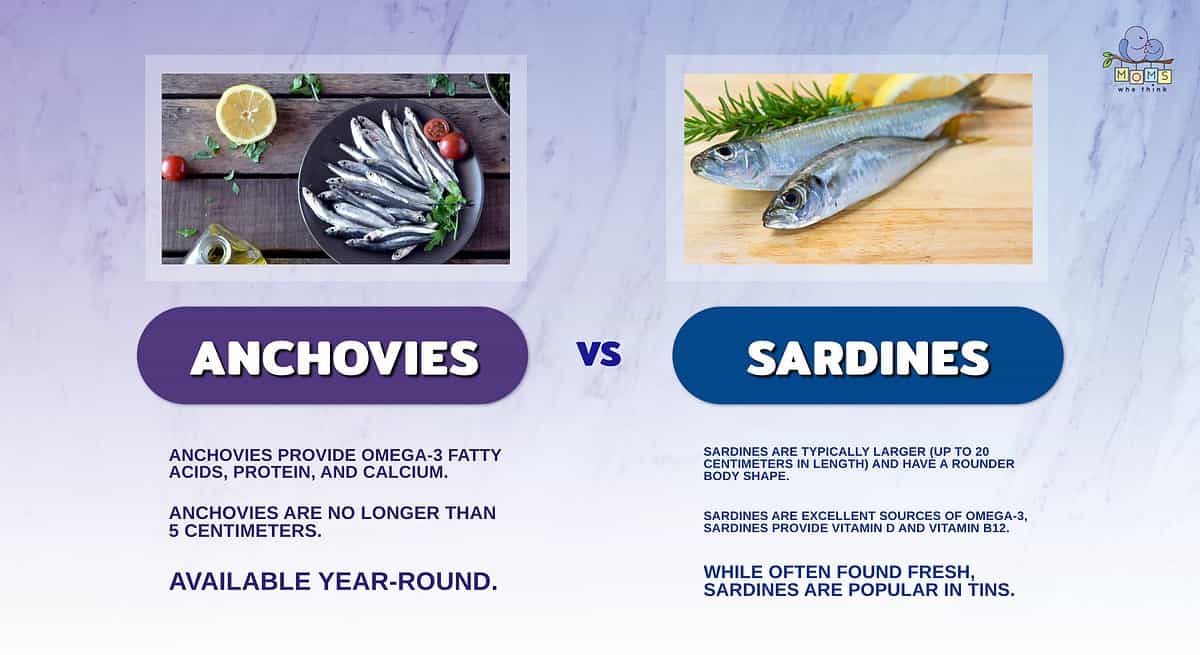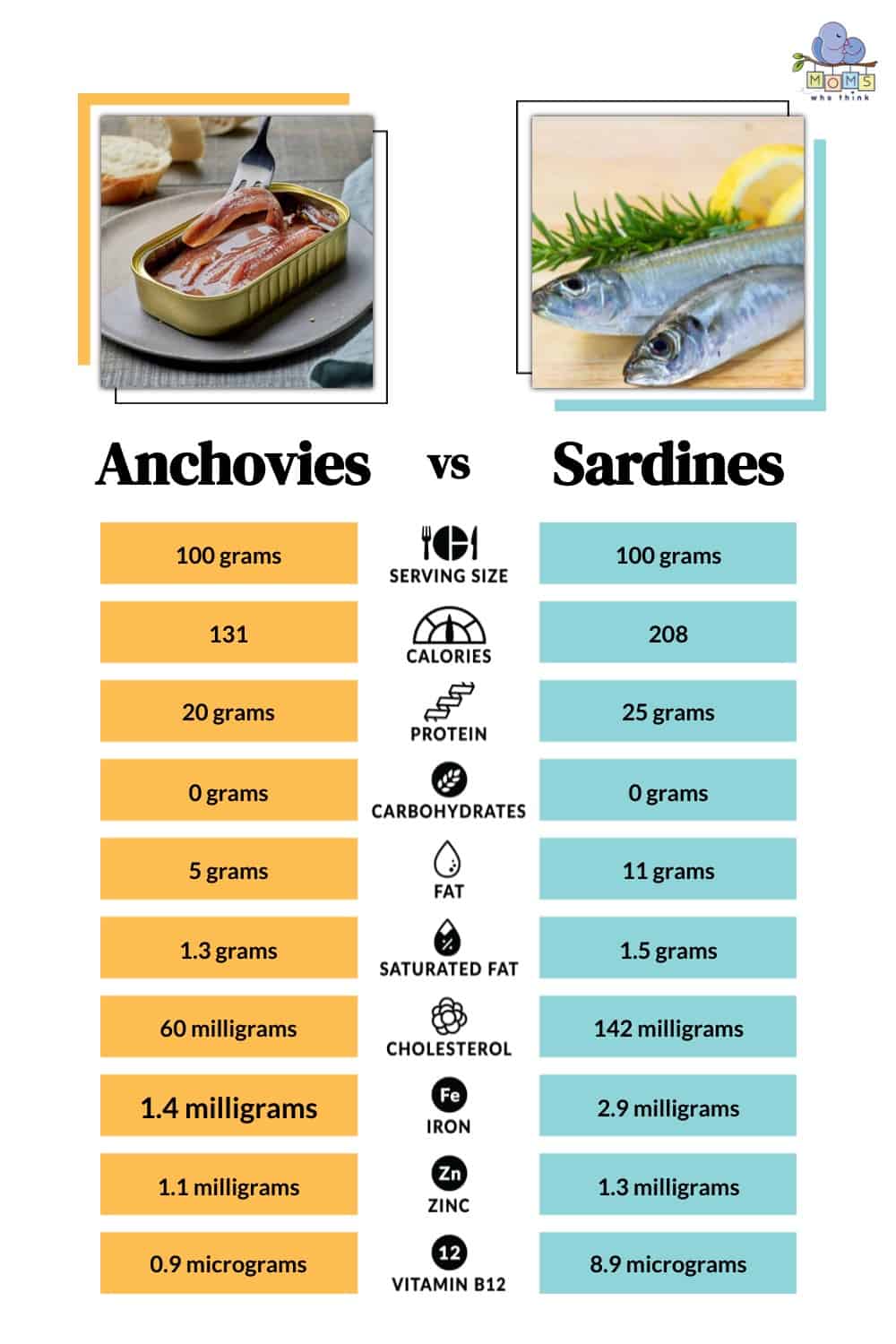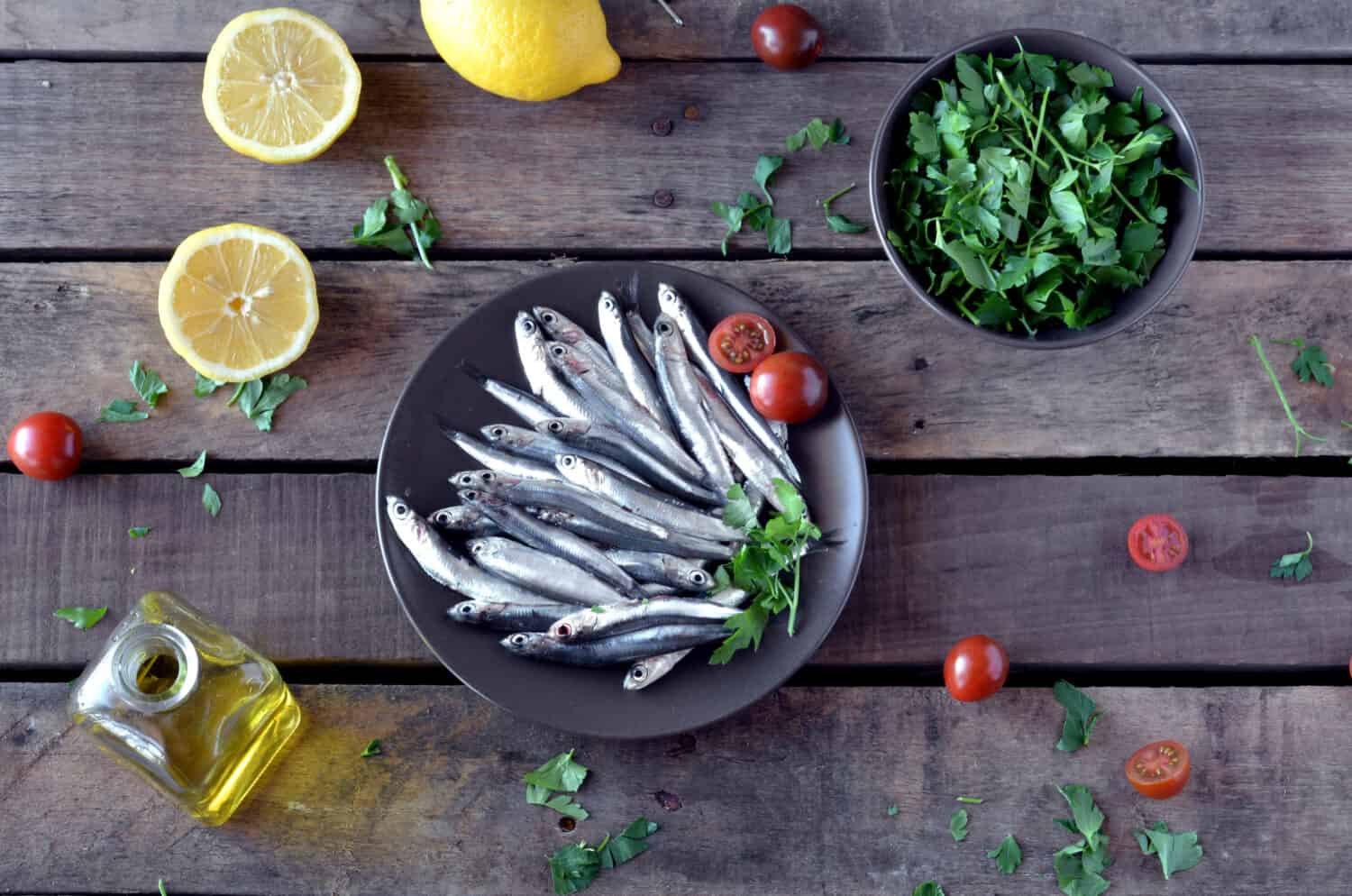Anchovies and sardines, small yet flavorful fish, enjoy widespread popularity around the world. Thriving in warmer ocean waters, both fish swim in schools to protect themselves from larger ocean predators. Moreover, both species feed on plankton. Their nutritional profiles are also strikingly similar.
However, there are important differences between these two oily fish. Although both have strong fishy flavors and firm textures, canning changes their tastes. Typically, manufacturers lightly cook sardines whereas they heavily salt anchovies. There are other key differences between these two fish, too. Let us consider the differences between them and discover if one is healthier.
Anchovies vs. Sardines: What are they?

While anchovies and sardines are small fish that look similar, they are not the same. Sardines belong to the herring family while anchovies are saltwater forage fish. Since both are small, they have less mercury than other kinds of fish.
Anchovies are smaller than sardines with long bodies and pointed snouts. They are no longer than five centimeters in length. Sardines are typically larger (up to twenty centimeters in length) and have a rounder body shape. Additionally, sardine scales tend to be silver with some dark spots. However, anchovies have a green or blue scaling. Anchovies are available year-round, whereas sardines are available between July and November each year.
Both fish thrive in the warmer waters of the Atlantic and Pacific oceans. Anchovies also appear in the Indian Ocean and areas like the Mediterranean Sea and the Black Sea. Sardines appear in large numbers along the coast of California and the coastlines of South America. They overlap in some areas since both fish prefer warm water.
Sardine populations are larger, which makes them the more sustainable seafood option. Since they play an essential role in the ecosystem of the ocean, maintaining their numbers is crucial. Luckily, they reproduce quickly and have less fluctuations in population than anchovies. Changes in climate, overfishing, and changes in the ocean ecosystem have affected anchovy populations, making them the less sustainable option.
Look for products that have been endorsed by the Marine Stewardship Council (MSC). Certification by such organizations ensures you are supporting companies with responsible fishing practices.
Anchovies vs. Sardines: Key differences
Here is a table noting the key differences between anchovies vs. sardines.
| Anchovies | Sardines | |
|---|---|---|
| Body | They are smaller than sardines and have a pointed snout. | Sardines are larger than anchovies and have a more streamlined appearance. |
| Appearance | Anchovies' scales are blue and green. | Sardines haves soft, silver scales with some bluish dark spots. |
| Habitat | These fish are found in the warmer waters of the Atlantic, Pacific, and Indian Oceans. | Appearing in large schools near the coasts, sardines also appear in the Atlantic and Pacific Oceans. |
| Availability | Harder to find fresh, they are available in tins and cans. Typically, the fillets are packed in salt and/or oil. | While often found fresh, sardines are popular in tins. |
| Nutrition | Anchovies provide Omega-3 fatty acids, protein, and calcium. | Also excellent sources of Omega-3, sardines provide Vitamin D and Vitamin B12. |
Anchovies vs. Sardines: Nutritional Comparison
Anchovies and sardines are great sources of healthy fats, vitamins, and minerals. Both of these fish provide Omega-3 fatty acids, which promotes brain function and heart health. Moreover, Omega-3 fatty acids reduce inflammation in the body. Both fish also provide essential nutrients, including protein, selenium, and Vitamin D. The table below provides an overall nutritional comparison for both fish.

Anchovies, due to their intense salting process, tend to be higher in sodium. The salt adds flavor, but this might be a concern for people monitoring their sodium intake. For those concerned about salt levels, sardines might be a better option because they are canned without excessive salt.
Nutritionally speaking, both fish have their merits. Determining which fish is better than the other will largely depend on your nutritional needs and diet. Also, you may prefer the taste of one fish over the other. A well-rounded selection of healthy foods, including anchovies and sardines, leads to a healthy diet. It is not so much about one fish being better than the other, but rather which fish aligns with your tastes and dietary needs.
Anchovies vs. Sardines: How to Eat Them
The process of salt-curing gives anchovies its distinctly salty taste. For this reason, they often appear on pizza or in pasta sauces like Puttanesca. Sardines often appear as appetizers. Packed with oil, people include them in sandwiches and salads. Additionally, they grill or fry fresh sardines to add to main dishes.
When shopping for anchovies and sardines, pay attention to where they were packed and what they are preserved in. Manufacturers pack high quality sardines in olive oil rather than water because they stay fresh longer.
Anchovies packed in olive oil are also better than those packed in water. Moreover, larger anchovies are better than smaller ones. Debone and rinse salt-packed anchovies before eating them.
When cooking with anchovies, opt for the oil-packed fillets to add a flavor similar to Unami to your dishes. Mash and combine anchovies with other ingredients in recipes like this one for olive tapenade. Anchovies are also popular in salads and pasta, particularly Caesar salad.
Additionally, sardines are extremely versatile. Besides eating them straight out of the tin, cooks can, broil, fry, puree, and even stew sardines. Like anchovies, sardines appear in pasta dishes and salads. Some folks even enjoy them on toast.
However, anchovies and sardines are not interchangeable in recipes because each fish has a distinct flavor. When cooking with both fish, always consider how salty these fish are and adjust your recipe accordingly. Moreover, a little bit of anchovies and sardines go a long way. Always start adding small amounts of fish to your dish and adjust as needed.

©AS Foodstudio/Shutterstock.com
In Summary
While anchovies and sardines are small, oily fish with many similarities, they are not interchangeable in the kitchen. Each fish has a distinct flavor profile. Anchovies, in particular, are extremely salty, and recipe adjustments should be made accordingly. In addition to their versatility, both fish have powerful nutritional profiles. They are excellent sources of Omega-3 fatty acids and minerals like selenium. Incorporating anchovies and sardines into your diet can provide a wide range of health benefits, but as always consider your individual health concerns first.
Print
Pizza Baked Fish Recipe
- Yield: 6 1x
Description
Not a huge fan of fish but trying to introduce more to your diet? This recipe is a wonderful way to explore the flavors of fish mixed with foods your taste buds are familiar with.
Ingredients
- 1/2 pound sliced fresh mushrooms, divided
- 2/3 cup chopped onion
- 1/2 teaspoon minced garlic
- 3/4 cup water
- 1/2 cup tomato paste
- 1 teaspoon dried basil leaves
- 1 teaspoon dried oregano leaves
- 1/4 teaspoon sugar
- 1/8 teaspoon crushed red pepper flakes
- Salt and pepper
- 2 pounds red snapper fillets or fish of choice
- 1 green bell pepper, seeded and sliced into rings
- 1 cup shredded part-skim Mozzarella cheese
Instructions
- Preheat the oven to 400°F.
- In a non-stick skillet, combine half the mushrooms, the onion, and the garlic, and sauté over medium heat until tender, about 5 minutes.
- Add the water, tomato paste, basil, oregano, sugar, red pepper flakes, salt, and pepper.
- Bring to a boil, reduce heat, and simmer, uncovered, for 5 minutes, stirring occasionally. Remove from heat.
- Place the fish in a 2-quart oblong baking dish coated with nonstick cooking spray. Season with salt and pepper, and pour the sauce over the fish.
- Top with the remaining mushrooms and the green pepper rings. Bake the fish for 15 minutes. Sprinkle with Mozzarella, and continue baking for 5 minutes, or until the fish flakes with a fork and the cheese is melted.
- Serve immediately.
Nutrition
- Calories: 243
- Sodium: 204mg
- Fat: 5g
- Saturated Fat: 2g
- Carbohydrates: 10g
- Fiber: 3g
- Protein: 38g
- Cholesterol: 67mg
The image featured at the top of this post is ©Enfoca y dispara/Shutterstock.com.


